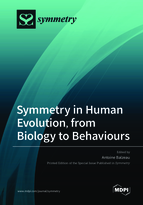Symmetry in Human Evolution, from Biology to Behaviours
A special issue of Symmetry (ISSN 2073-8994). This special issue belongs to the section "Life Sciences".
Deadline for manuscript submissions: closed (28 February 2022) | Viewed by 39033
Special Issue Editor
Department of African Zoology, Royal Museum for Central Africa, 3080 Tervuren, Belgium
Interests: human evolution; paleoneurology; hominins; behaviours; asymmetry
Special Issue Information
Dear Colleagues,
Our knowledge of human evolution has made particular progress over the last twenty years, thanks to the discovery of new fossils, the use of new methods and multidisciplinary approaches. Moreover, studies of departure from symmetry, including variations in fluctuating or directional asymmetries, have contributed to the expansion of this knowledge in various fields of paleobiology and archaeology. This Special Issue brings together articles dealing with symmetry and human evolution. In this context, the notion of symmetry is addressed—whether to reconstitute and reconstruct partial or deformed fossil specimens, identify gene transmissions between human species, study biological variations within hominins or compare them with extant primates, address the shape of the brain, seek possible relationships between biological and behavioural data or directly address behaviours through the analysis of the production of prehistoric humans (tools, artistic productions, etc.)
Submit your paper and select the Journal “Symmetry” and the Special Issue “Symmetry in Human Evolution, from Biology to Behaviours” via: MDPI submission system. Our papers will be published on a rolling basis and we will be pleased to receive your submission once you have finished it.
Dr. Antoine Balzeau
Guest Editor
Manuscript Submission Information
Manuscripts should be submitted online at www.mdpi.com by registering and logging in to this website. Once you are registered, click here to go to the submission form. Manuscripts can be submitted until the deadline. All submissions that pass pre-check are peer-reviewed. Accepted papers will be published continuously in the journal (as soon as accepted) and will be listed together on the special issue website. Research articles, review articles as well as short communications are invited. For planned papers, a title and short abstract (about 100 words) can be sent to the Editorial Office for announcement on this website.
Submitted manuscripts should not have been published previously, nor be under consideration for publication elsewhere (except conference proceedings papers). All manuscripts are thoroughly refereed through a single-blind peer-review process. A guide for authors and other relevant information for submission of manuscripts is available on the Instructions for Authors page. Symmetry is an international peer-reviewed open access monthly journal published by MDPI.
Please visit the Instructions for Authors page before submitting a manuscript. The Article Processing Charge (APC) for publication in this open access journal is 2400 CHF (Swiss Francs). Submitted papers should be well formatted and use good English. Authors may use MDPI's English editing service prior to publication or during author revisions.
Keywords
- Evolution
- Biodiversity
- Paleoneurology
- Hominins
- Archaeology
- Prehistory
- DA
- FA
- Departure from symmetry






